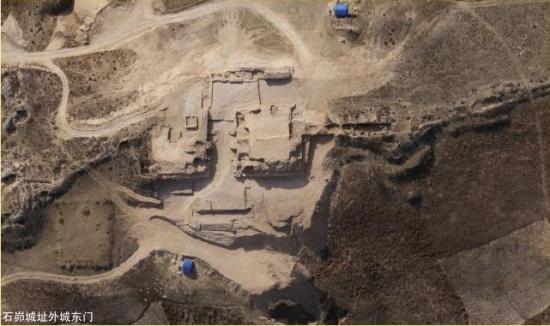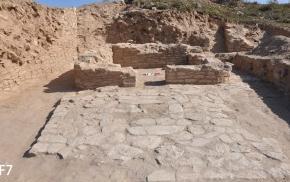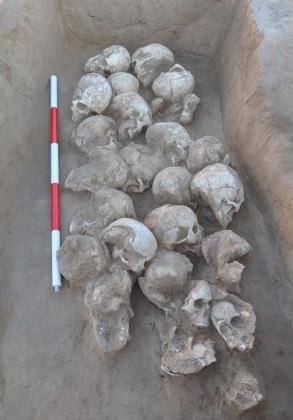Chinese Institute of Archaeology
Source - http://www.kaogu.cn/en/detail.asp?ProductID=3883
The Shimao site is located near Dongchuangou in Gaojiabao Town, Shenmu County, Shaanxi province, where the Tuwei River, one of the branches of the Yellow River, and the Dongchuangou joined together. A great scale stone-made walled and ditched site was found in 2011 there. In 2012, under the approval of the State Cultural Heritage Administration of China, the Joint Archaeological Working Team consisting of Shaanxi Provincial Institute of Archaeology, Yulin Municipal Relics Prospecting Team and Shenmu County Culture and Sports Bureau, carried out an excavation and reexamination. As a result, great achievements were made.

Archaeological Investigation: great-scaled stone-made walled and ditched site
In 2012, the Shimao Archaeological Team carried out a detailed investigation on the structure of the site and its orientation, confirming that the Shimao stone-made walled and ditched site consisted of three complete and relative independent stone-made enclosures, which were Huangchengtai walled platform, Inner Enclosure and Outer Enclosure. Huangchengtai walled platform was named by the local people for this high stone-made platform, which was surrounded by stone-made slope and was almost a square with remained area over 8 ha on the top of platform. It was located in the center of the west part of the Inner Enclosure. At present, the best-preserved part is located in the northeast corner. Its total length is about 200 meters and its height is between 3 and 7 meters. Huangchengtai walled platform does not have obvious stone-made wall but stone-made parapet slope based on the mountain. The Inner Enclosure surrounded the Huangchengtai walled platform and was built along the mountain. It shaped as an ellipse in northeast-southwest direction. The remained part is over 5700 meters long and about 2.5 meters wide. The best-preserved part is about more than 1 meter above the current ground. The Outer Enclosure was an arch-shaped stone-made wall, using the southeast part of the Inner enclosure to build southeastwards. The remained part is about 4200 meters long and about 2.5 meters wide. The best-preserved is more than 1 meter above the current ground.
This investigation found the enclosure wall crossing a ditch. On the Inner Enclosure and Outer Enclosure, there were the impressions caused by climbing from the bottom of the ditch to the stone-made enclosure along the slope. In the Outer Enclosure, a widened stone-made wall was found at the bottom of the ditch. The phenomena mentioned above firstly closed the discovered walls in Shimao and formed a relative closed independent space, supplying an important material for discussing the early geomorphologic change and environment in Shimao. Applying ArcGis system to measure and calculate, the Inner Enclosure covered approximately 210 ha and the Outer Enclosure covered approximately 190 ha. In all, the Shimao walled site covered more than 400 ha.

On the Huangchengtai walled platform, the Inner Enclosure and the Outer Enclosure, there were gates discovered. On the Inner Enclosure and the Outer Enclosure, square stone-made buildings, which were similar to crenels in shape, were found on the wall. On the Outer Enclosure, a protruding structure on the wall, which was suspected to be a crenel functioned as resisting the enemy, was found.
It was primarily analyzed that the chronology of the Shimao stone-made Enclosure was the same as the main remains of the site, if that is the case, the Shimao site would be a super large-scaled central settlement dated between the late Longshan Culture and the early Xia Dynasty. East Gate Remains of the Outer Enclosure: large-scaled, complex structure, advanced construction technology
From May to November of 2012, in order to solving the chronology of the Shimao walled and ditched site, further understand the layout inside the site and its functional districts, a gate locating outside the north Outer Enclosure was specially excavated. The East Gate was located in the northeast Outer Enclosure and the doorway was towards northeast. It consisted of one Outer wengcheng gate-enclosure, two stone-wrapped rammed earth platform, one zigzag Inner wengcheng gate-enclosure and one menshu gate room etc. These buildings were connected by an about 9 meters wide『-shaped doorway. In hypsography, the East Gate of the Outer Enclosure was located on the highest area in the site. It was open, strategically located and difficult for accessing.
The main potteries discovered from the upper layer of the East Gate doorway, were high neck li鬲 tripods with thin chords pattern, single-handle li tripods with square pattern, flower brim li tripods and wide mouth gui 鬶 tripods, folded-shouldered guan罐jars with basket pattern. What were discovered from the lower layer were mostly pottery shards with chord pattern and basket pattern in a small number. The potteries were mainly li tripods and jars. Although the potteries from the two layers were very different in shape, styles and patterns, their stratigraphic relations showed that the upper and lower grounds of the East Gate of the Outer Enclosure could divide the chronology of the site into early and later phases, representing construction and re-construction phases. The relics from the two layers were dated to the late Longshan culture and Xia Dynasty respectively. So, the chronology of the East Gate and even the Shimao stone-made enclosure should be dated between the late Longshan culture and the early Xia Dynasty.

The Outer wengcheng gate-enclosure was U-shaped in plane, totally covering the doorway, but did not completely connect the two crenels locating at the entrance of the doorway with passageway left in the south and north end. The stone-made wall of the Outer wengcheng gate-enclosure was repaired several times and was re-built after it was abandoned. Moreover, a stone-made square house foundation was newly built in the southeast corner of the Outer wengcheng gate-enclosure. In the deposit of the collapsed wall, jade spades, huang pendent ornament and stone carved figure heads were unearthed.
The rammed earth platforms were symmetrical built on south and north sides taking the doorway as a boundary. They were rectangle and wrapped outside with stones. Inside the platforms was rammed earth. Moreover, outside rammed earth platforms were wrapped with stone-made wall (temporarily called Main Wall). There was another layer of stone-made wall outside the platforms (temporarily called Parapet Wall), tightly attaching to the Main Wall and totally wrapping the east wall of the platform and the two east corners. Under the Parapet Wall, there was a 1.2-1.5 meters wide stone-made rectangle structure along the wall. It was similar to drainage in shape. On the Main Wall towards the doorway built three parallel short walls respectively in south-north direction. These three short walls divided the space into four rooms probably functioned as gate rooms. They distributed symmetrically in south and north, and there were even cooking stove remains in some of the gate rooms. The floors of the gate rooms were built regularly and the impressions caused by tread were obvious. The floors dating to the early and late phases could correspond to the doorway.
The rammed earth at the top of the north platforms was about 6 meters long and 14 meters wide. The Main Wall was 2.7-4.1 meters thick and the Parapet Wall was 1.5-2.8 meters thick. The drainage was 1.2-1.5 meters wide. The highest part of the platform was about 6.7 meters above the ground dating to the late Longshan Culture. A stone-made wall was built tightly close to the west side the Main Wall and it was 1.3 meters wide, wrapping the southwest corner of the platform.
The rammed earth at the top of the south platform was about 17 meters long and 11 meters wide. The Main Wall was about 4.2 meters thick and the Parapet Wall was 2-2.5 meters. The drainage was destroyed heavily and there was about 1.3 meters left in the widest part. The highest part was about 5.6 meters above the ground dating to the late Longshan culture. A few Parapet Walls were built to the west of the collapsed platform during the Xia Dynasty and an independent room possibly functioned as a courtyard was built in the west side of the platform. In the independent room, a stone-made house foundation F7 was the main part. F7 was square in plan, covering about 10 square meter inside. The house wall was about 80cm wide and 60cm thick. The doorway was towards west and stone slabs were paved outside, forming the independent room functioned as a courtyard. There were flower brim jars, high neck li tripods and so on, dating to the late phase from F7. In the deposit of the courtyard wall, there was a carved stone figure face unearthed.
There was a zigzag wengcheng gate-enclosure structure inside the gate. The stone-made wall was about 2.5 meters wide. There were more than 100 mural fragments found on the surface at the bottom of the wall and these fragments were distributed in layers and pieces. Some of the mural fragments were still attached on the wall dating to the late phase. These murals took lime surface as background and geometrical patterns were drawn in red, yellow, black and orange, etc.

In addition, it is noteworthy that two remains with human skulls buried in concentration were discovered under the lower ground and there were 24 human skulls in all. One was located outside the wall of the outer wengcheng gate-enclosure in south-north direction, and the other one was located at the entrance of the doorway, closing the north platform. The human skulls arrangement patterns at the two sites seemed to have some certain law but there was not obvious sign showing the human skulls were put in pits. After primarily identified, these human skulls were mostly female, and some of them had obvious cutting traces. Moreover, there were burned traces at a few occipital bones and the lower jaws. They were possibly related to the ritual or foundation activities during the construction of the Enclosure.
In 2012, besides the excavation of the East Gate of the Outer Enclosure, a few sites inside the Inner Enclosure were test excavated: Yuangadan, Houyangwan, Hujiawa, Duimianliang and Yebianfuta. Some typical potteries dating from the middle Longshan culture to the Xia Dynasty were unearthed. The academic significance and primary understanding The archaeological excavation of the East Gate of the Outer Enclosure at Shimao in 2012, confirmed the gate remains, stone-made walls, platforms, gate rooms, inner wengcheng gate-enclosure and outer wengcheng gate-enclosure and some other important remains with the large-scaled, complex structure and advanced construction technology. Moreover, there were jades, murals and a large number of potteries, stone tools, bone artifacts and others discovered dating from the late Longshan culture to the Xia Dynasty.
In addition, there were some potteries and jades with obvious chronological characteristics and remains with clear stratigraphic relationships discovered, supplying important evidences for confirming the chronology of the Shimao enclosure. Combined the stratigraphic relationships with the unearthed relics, it was primarily determined that the Shimao enclosure was firstly built (Huangchengtai walled platform) in the middle Longshan culture or slightly later, thrived in the late Longshan culture and abandoned in the Xia Dynasty. It was a super large-scaled central settlement in Northern China. The large-scaled stone-made walled and ditched site and the large number of Shimao jades showed the core position of the Shimao site in the Northern Culture Circle. The Shimao Enclosure covered more than 400 ha, larger than the Liangzhu Enclosure and Taosi Enclosure which were close to Shimao in chronology, so it became the largest prehistory enclosure in China. The excavation not only supplied scientific background for the chronology of the Shimao jades and their cultural properties, but also played an important role in further understanding the early civilization structure under the frame of “archaic state, regional state, empire”. (Translator: Zhai Shaodong)